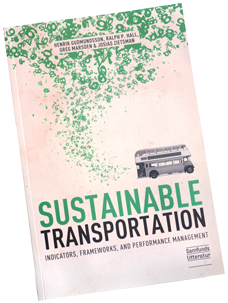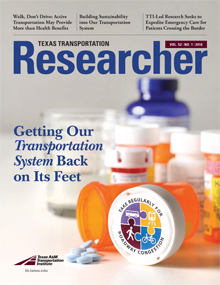Vital to economic growth, transportation can also be a detriment to human health and the natural environment. That’s among the reasons why the concept of sustainable transportation is emerging in countries around the globe, among most state departments of transportation in the United States and, in increasing cases, as part of transportation engineering curricula.
“Sustainable transportation is an extremely broad topic that has hundreds of different definitions and could mean different things to different people,” explains Joe Zietsman, head of the Texas A&M Transportation Institute’s (TTI’s) Environment and Air Quality Division. “For some, it means the attempt to reduce congestion with high-occupancy vehicle lanes or reduce greenhouse emissions. For others, it’s wise land use and planning that makes room for sidewalks and bike lanes. Sustainable transportation is really a philosophy that should be incorporated into all aspects of transportation practice and decision making.”
TTI’s Sustainable Transportation Research
Early TTI work focusing on sustainable transportation included a 2002 Zietsman-led project sponsored by the Southwest Region University Transportation Center — Quantifying Sustainable Transportation Performance Measures. The project goal was “to provide a framework on how to identify, quantify and apply performance measures for sustainable transportation in the transportation planning process.”
Six years later, in 2008, Zietsman and a team of TTI researchers developed a performance-measurement approach to evaluate sustainability in the context of the goals of the strategic plan initiated by the Texas Department of Transportation (TxDOT) — reduce congestion, improve safety, increase economic opportunity, enhance the value of transportation assets and improve air quality. The team of researchers developed a methodology and an analysis tool to evaluate progress toward sustainability.
The TxDOT project led the way for a national effort to help all state transportation agencies identify and apply sustainability-related performance measures. National Cooperative Highway Research Program (NCHRP) Project 708, A Guidebook for Sustainability Performance Measurement for Transportation Agencies, was completed in 2011 and helped move sustainable transportation efforts to a new level. Zietsman collaborated with numerous experts for the NCHRP project, which led to a recently published textbook, Sustainable Transportation: Indicators, Frameworks, and Performance Management (see sidebar). In 2014, Zietsman used the NCHRP guidebook to help the Roads Authority of Namibia develop a Road Transport Sustainability Plan for the nation’s transportation network.
Health and Transportation Projects
The connection between health and transportation has now become a strategic initiative at TTI. The Institute has partnered with the Texas A&M Health Science Center (TAMHSC) following a collaborative workshop last year designed to examine future research opportunities. Two team projects are now under way — one that links crash data with individual patient outcomes (which could lead to improved treatments, faster emergency responses and effective safety countermeasures) and another that evaluates the health consequences of vehicle emissions along the Texas-Mexico border.
“Hidalgo County has among the highest rates of childhood asthma in the state. Is it related to worsening air quality issues along the border?” asks Natalie Johnson of the TAMHSC School of Public Health. “On the health side of the project, we’re monitoring air pollution exposures of 25 expectant women through blood and urine samples. But we need TTI researchers to help us understand how the transportation sector is contributing to these exposures.”
The Strategic Research Development in Health and Transportation Initiative will help to develop additional research opportunities between health professionals and transportation researchers. “We are in the early stages of making sustainable transportation a priority,” Zietsman says. “The concept is not going away. Terminology may change, but the principle is here to stay.”



